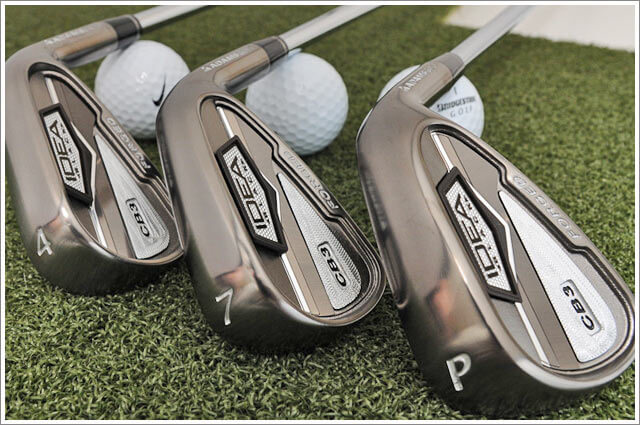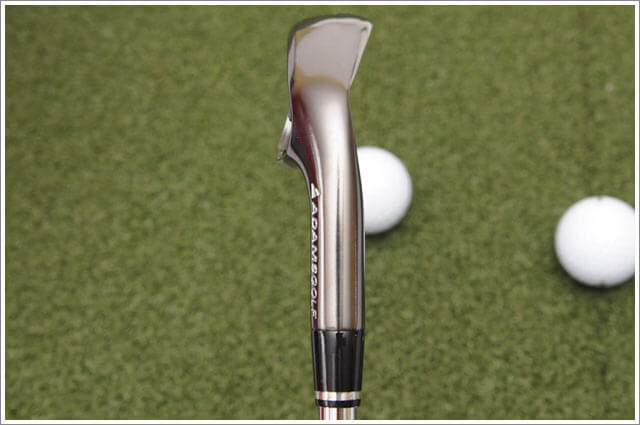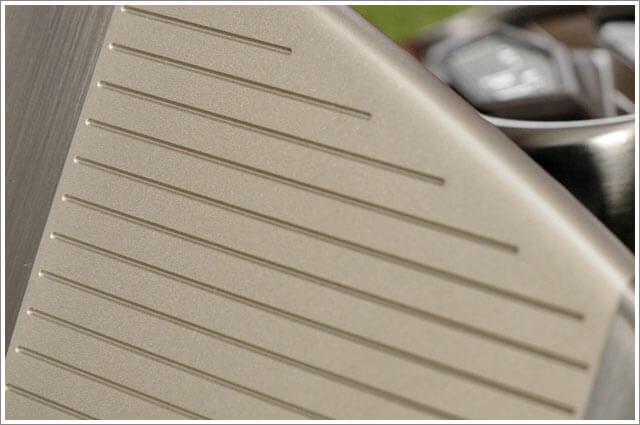*** GIVEAWAY – WIN A SET OF ADAMS CB3 IRONS! ***
MyGolfSpy is giving away (2) sets of Adams CB3 Irons. Contest has ended. Congratulations to our Winners:
- Zac B.
- Brad C.
Adams Idea Black CB3 Irons
(Written By: GolfSpy T) When our contact at Adams dropped me a message to let me know we had some demos of the new Idea Black CB3 irons on the way I jumped to the conclusion that they would fall between the MB2s and the Idea Pro a12s the Adams lineup. Even after unpacking the irons it didn’t occur to me to double-check those initial impressions. Hell…even when I was going back and forth with TaylorMade discussing what their acquisition of Adams would mean for the better player irons in the Adams lineup; I actually used the Adams CB3 as an example.
Fortunately, before I got golf balls deep into this review I decided to get confirmation on the placement of the irons from Adams. It turns out I was wrong. They fooled me, Jerry!
The reality of the situation is that within the current Adams lineup the Idea Black CB3 falls between the Idea Pro a12 (what I call a transitional iron), and the SGI Idea a12 OS (most definitely super (duper) game-improvement. Sure…if I had initially taken the time to look the CB3’s over, I would have been able to piece it all together, but at a quick glance, it was an easy mistake to make. As you’ll learn time and time again throughout the course of this review, while the Idea Pro Black CB3 might qualify as a game-improvement iron, it barely looks the part, and that perhaps is what makes it so damn appealing.
The Marketing Angle
Adams is billing the Idea Black CB3 Irons as having Better Looks, Better Feel, and Better Playability. Here’s the short story of what makes that possible:
- Forged 8620 carbon steel – triple milled (cavity, face and grooves)
- Black Ni/Cr PVD finish with a glass beaded face to produce an exceptional look at address.
- Engineered with progressive sole widths that allow for easier to hit long irons and deadly accurate scoring clubs.
- Scoring clubs designed with improved bounce and camber to reduce turf interaction for more workability and control.
How We Tested
To find out more about how we test our irons: CLICK HERE
Radius-Based Scoring
For more information on our “Radius Based Scoring System”: CLICK HERE
Our test sets included 4-GW with KBS Tour 90 shafts in both stiff and regular flex.
PERFORMANCE SCORING
Short Iron Performance
While not quite the 44° model we saw withe the Wilson Ci11 irons we tested, for the CB3, Adams too has gone with a strongly lofted pitching wedge. Of course, strongly lofted is a matter of opinion, and for better or worse, 45° is quickly becoming standard for game improvement sets as the 3-iron disappears, and the gap wedge ingrains itself as fixture in the modern iron set. As you might expect, shafts too have been lengthened (again, compared to a traditional pitching wedge), with the PW playing at standard 9-iron length, and the gap wedge measuring standard for most pitching wedges. All of this makes perfect sense. When you factor in loft and length, the pitching wedge is basically a 9-iron anyway.
Would anybody be surprised if I told you that most of our testers found the entire set 1 or more clubs longer than what many have in their bags right now?
Looking at the actual data we found that our testers missed the pin by an average of 26.57 feet. That’s within our average range, and is perhaps higher than it might otherwise have been. One simply didn’t hit the CB3s well across the board. The 2nd normally plays irons bent 2° flat, so that certain could also impact accuracy (we’ll be moving to more of a custom fit model for testing, which should help mitigate these sorts of fitting issues).
When we adjust the average by removing our least accurate tester from the equation, distance from the pin improves to 23.43 feet, placing the CB3 right in the middle of all the irons we’ve tested under the new system.
As you can see from the chart, misses tended to favor the left side. Perhaps most surprising is that more of the misses to that side fell short. Generally speaking golfers will miss short right and long left.
Looking simply at our tester’s ability to hit the short irons straight, we see that our testers missed the center of the target line by an average of 19.03 feet. When we adjust the average, accuracy improves to 15.88 feet, which suggests our testers weren’t quite as straight as they’ve been with some of the other irons we’ve tested.
When we look at our testers ability to reach the target distance (regardless of left/right orientation), we see that our golfers missed the distance by an average of 14.95 feet. With the least consistent tester removed, distance control improves to 13.93 feet, which is above average for the irons we’ve tested to date.
Finally, when we look more closely for birdie opportunities we find that our group of testers as a whole managed 6 shots (from (3 different testers) inside of 10 feet. Bumped out to 15 feet, the number of birdie opportunities jump to 15.
In general we saw some bigger misses than we generally see with short irons, and that may be due to the CB3s very un-game-improvement take on game-improvement, however, the best shots were also generally tighter to the pin than we normally see from clubs in this category.
Short Iron Performance Score 89.39
Middle Iron Performance
With middle irons (defined in this test as 6-8 irons), our testers missed the pin by an average of 29.54 feet. As it always does, the average improved to 27.60 feet when our least accurate tester was removed. While it’s not a stellar number, it’s squarely middle of the pack for the irons tested to date.
Looking at our golfer’s ability to hit the ball straight, we find that our testers missed the center line by an average of 19.76 feet. When we eliminate the golfer least able to avoid spraying like a graffiti artist crystal meth, left/right dispersion improves to 17.98 feet.
Distance control played out similarly to left/right accuracy with our testers missing the distance by an average of 18.27 feet. With our least consistent golfer eliminated, the adjust average improves to 17.36 feet.
Looking at what matters most (legitimate birdie opportunities), we find that our testers were able to place 10 shots (at least one from all 6 testers) inside of 15 feet. If we’re feeling good about our putting and define birdie range as 20 feet, the overall number of reasonable one-putt chances increases to 17.
Middle Iron Performance Score: 91.58
Long Iron Performance
Not surprisingly, the majority of our long irons shots with the Adams Idea Black CB3 landed short and right of the target line (a fact in which played a substantial role in its creation).
On average our testers missed the pin by an average of 44.15 feet. With our least accurate tester removed, the group average improves to 39.59 feet, which like most of the accuracy numbers our testers posted for the CB3, is squarely in the middle of the pack.
Looking at proximity to the center line, we see that our testers missed the mark by an average of 33.91 feet, and 28.31 feet adjusted.
Looking at our tester’s ability to get the distance, we find that our testers missed their target distance by an average of 20.65 feet. When the least consistent tester is removed, accuracy improves to 17.89 feet, which makes the Adams Idea Black CB3 (as of the time of this writing) #1 overall for long iron distance control.
Looking at birdie chances (inside 20 feet) we find only 5 shots from 3 different testers. If we’re feeling generous and bump the distance out to 25 feet, the number of one-putt opportunities increases to 13.
Long Iron Performance Score: 89.99
Performance Notes
Overall the Adams Idea Black CB3 proved to be a very solid game-improvement iron. This is one of those cases where I feel like the scores came back a bit lower than what I personally think the iron is capable of producing. Given that we had two first time testers, and one of our other testers clearly didn’t have his absolute best stuff, it’s reasonable to think there may be a few more points out there, but lines must be drawn, and this is that.
MGS OVERALL PERFORMANCE SCORE: 90.31
The Interactive Data
The charts below show the individual and group averages (black dotted line) for each shot our golfers took during our test of the Adams Idea Black CB3 Irons. You can click on each of 3 tabs (Adams CB3 – Short Irons, Adams CB3 – Mid Irons, Adams CB – Long Irons) you can see where each shot came to rest on our virtual driving range, and the raw data (averages) for each of our testers. Hovering over any point will give you all the details of that particular shot. You can use the filters on the right-hand side to show and hide individual golfer based on handicap and proximity to the pin. At your whimsy you can drag the Distance from Hole slider around to show you how many shots fell within the area you specify.
SUBJECTIVE SCORING
Looks
What really stands out to me is what ultimately could be the downfall of the CB3 in the marketplace. The damn thing doesn’t really look like a game-improvement iron. In many respects, the CB3 is simply a larger, potentially more forgiving version of the Pro a12 iron. The entire iron is basically done in gray scale; from the black nickel PVD finish, to the silver badge to the black ABS frame. It’s an absolutely beautiful game improvement iron, but the total lack of color (save the red on the KBS label) might turn off some GI guys who are accustomed to more than a splash of color in their irons.
While the topline is thick, it’s not intrusive (or offensive). Yes, soles are wider, but certainly narrower than what we see in most game-improvement designs (which suggests the CB3 might not be solidly in the GI category). There is a generous amount of offset, but the guys at Adams did a pretty solid job of blending it such that the hosel doesn’t look like its sitting well in front of the face.
While not as compact as a player’s cavity-back, the face is relatively compact, though is certainly taller than what I have in my bag now. The bottom line is that game-improvement designs have developed a bit of a reputation for being “shovels”. If you’re a fan of shovels, the CB3 may not be for you.
“The looks…reminded me of Titleist irons” – Lou Y. (how often do you hear that about a GI club?)
One other noteworthy aspect of the looks of the Adams CB3 irons, is the inclusion of what Adams calls progressive sole widths. Essentially, as the clubs get longer the soles get wider. Interestingly, this is the opposite of what Cobra did with their AMP Irons (as the clubs get longer, the soles get more narrow). The result of what Adams has done are short irons that look and play more like player’s cavity-back designs, long irons that look a bit more like, and play closer to traditional game-improvement irons, and middle irons that bridge the gap between the two. Effectively Adams has created one of the first true “combo sets” for mid to mid-high handicap golfers. How cool is that? Don’t answer…I’ll just tell you…it’s really, really cool.
While in many respects they play like a game-improvement iron, the Idea Black CB3 iron barely looks the part…and that’s good thing.
MGS Looks Score: 93.53
Sound & Feel
Whether you want to chalk it up to being forged, or simply the subjective impact that the idea of forged irons have, our testers mostly loved the feel of the Idea Black CB3 irons. While one of our testers told us that the middle irons felt lighter than the short irons, he still found the nebulous concept of feel to be outstanding at impact.
Truth be told, game-improvement irons have come a long way in just the last couple of years (where feel is concerned), so it’s not the surprise it used to be when we receive a great feeling game-improvement club.
Worth mentioning…I don’t think we can discount the shaft entirely in the feel equation. Irons that feature KBS shafts generally score better than those with most anything else in the feel category. The pattern suggests (as most would assume to be true anyway), the shaft definitely plays a role in the feel equation.
MGS Feel Score: 92.45
Perceived Forgiveness
Our surveys came back with some interesting results for forgiveness. Not surprisingly, the tester who struggled across the board didn’t find the CB3 to be a very forgiving club. The same is true of our senior tester (despite posting some of his highest performance scores to date). The CB3 more or less does what I’d expect a game-improvement iron to do. They produce mostly straight shots, and do a better job than most at keeping you out of trouble.
If there’s a knock it’s that the CB3 might be a bit more penal on shots hit high on the face compared to some of the other GI irons we’ve tested, but overall, it rates above average for forgiveness.
Tester Perceived Forgiveness Score: 91.38
Likelihood of Purchase
LOP scores broke down along the same lines as forgiveness scores. Several of our testers rated the club extremely high (and much higher than I’d expect from any game-improvement club), while our least accurate, and our most senior tester basically told us there’s no chance at all they’d purchase the CB3s. That’s going to happen with most any club, but what I find most telling is that a group of guys, many of whom habitually rate Game-Improvement irons low for likelihood of purchase told us that if they were going to purchase a more forgiving club than what they currently play, the Adams Idea Black CB3 would likely be the one.
Tester Likelihood of Purchase: 86.00
Just one guy’s opinion here, but when it comes to designing a game-improvement iron that might actually appeal to guys like (guys who thumb their noses at anything bigger than an Idea a12 pro iron for example) Adams basically did everything right. It’s a stunning iron that offers outstanding feel, and can easily make you forget your holding what is probably a game-improvement iron. If you love the idea of a game-improvement iron, but aren’t a fan of the aesthetic sacrifices often made to increase performance, we may have just found the iron for you.
TOTAL SUBJECTIVE SCORE: 81.38
CONCLUSION
I’ve talked in the past about the concept of a transitional iron…something between a game-improvement iron, and a players iron. While there are clearly several design elements that could squarely classify the CB3 as a GI iron, Adams doesn’t want to pigeonhole it into that category, and based on my experience, and what I saw from my testers, I can understand why. The CB3 is a bit of a unique offering. While we humans love our taxonomies, the CB3 isn’t an iron that fits comfortably into any of the categories we like to use. In my estimation, it sits somewhere between a transitional club, and a modern game-improvement iron. It offers the playability of the latter, but has the aesthetic appeal of the former.
As I said earlier, the Adams Black CB3 is in some respects a combo set for mid to mid-high handicap golfers. Those of you out there who want a more traditional look in your scoring clubs, but aren’t willing to sacrifice the forgiveness of your game-improvement long irons, finally have a set that truly offers the best of both worlds.
I don’t say this often when it comes to GI clubs, and I certainly don’t say it lightly; the Adams Idea Pro Black is solidly at the top of an extremely short list of game-improvement clubs (if you want to call it that), that I (and some of my testers) would actually consider putting in their bags.
MGS TOTAL SCORE: 89.38
*** GIVEAWAY – WIN A SET OF ADAMS CB3 IRONS! ***
MyGolfSpy is giving away (2) sets of Adams CB3 Irons. Contest has ended. Congratulations to our Winners:
- Zac B.
- Brad C.
DONATE
If you found this review and others useful, please consider making a donation to help support MyGolfSpy or a contribution to our Club Recycling Program. A PayPal account is not required in order to donate.
[donation-can goal_id=’fund-the-revolution’ style_id=’mgs’ show_progress=false show_description=false show_donations=false show_title=false title=”]


























gordon
11 years ago
Has anyone tried these with the graphite shafts?
I was thinking of the new Cobra Amp, but their lofts of too jacked up.
If anyone has played or hit some with the graphite shafts please let me know your thoughts and if they are worth the up charge from the KBS steel.
Thanks